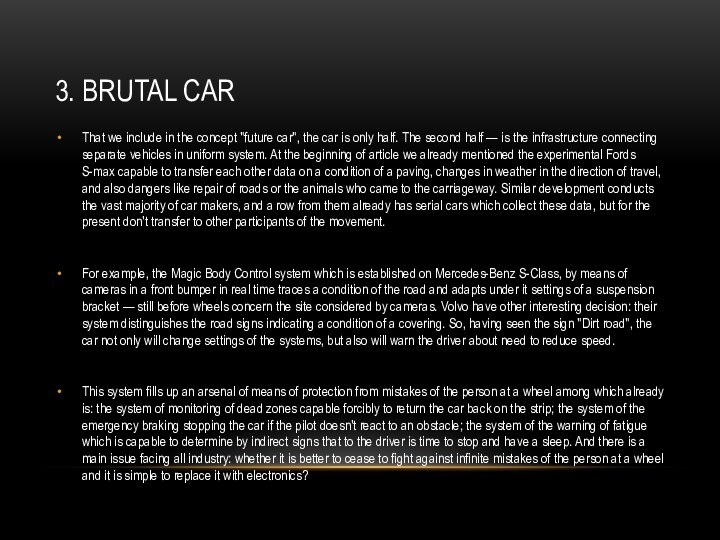- Главная
- Разное
- Бизнес и предпринимательство
- Образование
- Развлечения
- Государство
- Спорт
- Графика
- Культурология
- Еда и кулинария
- Лингвистика
- Религиоведение
- Черчение
- Физкультура
- ИЗО
- Психология
- Социология
- Английский язык
- Астрономия
- Алгебра
- Биология
- География
- Геометрия
- Детские презентации
- Информатика
- История
- Литература
- Маркетинг
- Математика
- Медицина
- Менеджмент
- Музыка
- МХК
- Немецкий язык
- ОБЖ
- Обществознание
- Окружающий мир
- Педагогика
- Русский язык
- Технология
- Физика
- Философия
- Химия
- Шаблоны, картинки для презентаций
- Экология
- Экономика
- Юриспруденция
Что такое findslide.org?
FindSlide.org - это сайт презентаций, докладов, шаблонов в формате PowerPoint.
Обратная связь
Email: Нажмите что бы посмотреть
Презентация на тему Future cars
Содержание
FUTURE CARS: THAT WAITS FOR US IN THE NEXT 15 YEARS We didn't see how dinosaurs died out, but we will see how cars of that look to which we already got used will die out.









Слайд 2 FUTURE CARS: THAT WAITS FOR US IN THE
NEXT 15 YEARS
but we will see how cars of that look to which we already got used will die out. Within the next 15 years there will be an automobile revolution. Prepare, the driver's seat shakes and under you too.
Слайд 4
1. What here communication?
We will begin with "interiors".
Process of evolution of cars goes constantly, but at
present the amount of new technologies reached critical level, and in the next years we will become witnesses of that it is quite possible to consider revolution. Today "under skin" cars there is a prompt replacement of mechanical communication on wire and wireless. For many years developers for safety reasons (and mostly not to frighten off buyers), avoided new technologies in the knots directly connected with management. But infinitely it is impossible to constrain progress.The first established relation with the motor on accelerator pedal wires. Then I came it is time to give way to check points levers to joysticks. And at last, I presented to Infiniti on the Q50 model the wheel deprived of mechanical communication with wheels, having finished thereby transition to completely electronic control.
Communication not only governing bodies with other systems of the car changes. The whole knots consign to the past: the driveshaft, a razdatka, differentials — all this loses the meaning in hybrid and electric cars in which motors are located directly on wheels. So, need for the details transferring a torque from under a cowl to the leading axes disappears. Estimate, what scale it is revolution if according to the forecast by 2040 50% of new cars are hybrid.
Habitual atmospheric motors die out. Without direct injection, pressurization and cunning electronics today not to fit into environmental standards any more, after all the average value of emissions of CO2 on a model range at car maker shouldn't exceed 95 g/km. So forgive to V12, V8 and V6.
Слайд 5
2. New skin
Usual steel which gives way twice
to stronger and by 5 times to lighter carbon
fabrics consigns to the past even. In 2008 in headquarters of McLaren near London showed me how carbonic monocoques of race cars build: "Carbon fiber very strong on a gap, but weak on a bend therefore threads are weaved into fabric on strictly counted "drawing" and are exposed to high temperatures. It practically handwork over each detail" — was told then by engineers.Passed 7 years, and today these "manual skills" were put on the conveyor — more and more producers are put in own plants on production of details from carbon fabrics. And if, say, Volkswagen experiments conceptual models from this material so far (such as city XL1), BMW already over a year lets out serial models — i8 and i3. In a case with i3 of technology of "Formula One" are applied not in the supercar, and in a city minicar. However, exactly such small cars will also become the main transport of the future (you remember, we spoke about traffic jams?).
At an exhibition of perspective development of Michelin Challenge Bibendum which passed at the end of 2014 in the Chinese Chengdu the general tendency was accurately visible: it was offered to replace scooters with a monopitchfork and polusegveyam (in fact, self-moving platforms for feet which can be carried with themselves), and habitual cars — supercompact cars (like already existing Renault Twizy) and public "clever minibuses".
For Ligier EZ10 example. This 6-seater pilotless electrobus is promised to release on roads of China in 5 years. For use of it to passengers will be to download the application on the smartphone enough: leaving the house, you enter the destination, and the next passing transport reports, in how many will be able to take away you at a stop. Perhaps, such "electric trains" will help residents of Celestial Empire to see again the sky which in the large cities of China is too often hidden behind a smog veil.
Слайд 7
3. Brutal car
That we include in the concept
"future car", the car is only half. The second
half — is the infrastructure connecting separate vehicles in uniform system. At the beginning of article we already mentioned the experimental Fords S-max capable to transfer each other data on a condition of a paving, changes in weather in the direction of travel, and also dangers like repair of roads or the animals who came to the carriageway. Similar development conducts the vast majority of car makers, and a row from them already has serial cars which collect these data, but for the present don't transfer to other participants of the movement.For example, the Magic Body Control system which is established on Mercedes-Benz S-Class, by means of cameras in a front bumper in real time traces a condition of the road and adapts under it settings of a suspension bracket — still before wheels concern the site considered by cameras. Volvo have other interesting decision: their system distinguishes the road signs indicating a condition of a covering. So, having seen the sign "Dirt road", the car not only will change settings of the systems, but also will warn the driver about need to reduce speed.
This system fills up an arsenal of means of protection from mistakes of the person at a wheel among which already is: the system of monitoring of dead zones capable forcibly to return the car back on the strip; the system of the emergency braking stopping the car if the pilot doesn't react to an obstacle; the system of the warning of fatigue which is capable to determine by indirect signs that to the driver is time to stop and have a sleep. And there is a main issue facing all industry: whether it is better to cease to fight against infinite mistakes of the person at a wheel and it is simple to replace it with electronics?





























